
22 Jul Cost to Replace Subflooring in Every Room Compared
You will see that the cost to replace subflooring changes by room. The average price depends on things like room type, materials, and labor. Here is a quick guess for each room using new industry data:
Room Type | Average Cost Range |
|---|---|
Bedroom | $450 – $1,500 |
Living Room | $900 – $3,000 |
Kitchen | $600 – $2,000 |
Bathroom | $120 – $400 |
Basement | $3,000 – $10,000 |
If you want to replace subflooring in the bathroom, the cost is lower. The living room or basement will cost a lot more. Always measure your room and get a price before you begin. Labor and materials can change the total cost in every room.
Key Takeaways
The cost to replace subflooring is different in each room. Bathrooms cost the least. Basements cost the most. Labor, materials, room size, and how much damage there is all affect the total price. It is smart to use water-resistant materials in wet rooms. Kitchens and bathrooms need these materials. Getting more than one quote can help you save money. Planning early helps you avoid surprises. Taking care of your subfloor keeps it from getting damaged. Fixing problems fast can make your subfloor last longer.
Room Costs
Kitchen
It usually costs more to replace subflooring in the kitchen than in other rooms. Most people spend between $1,500 and $5,000 for this job. This price covers both labor and materials. Kitchens are often 120 to 250 square feet in size. If your kitchen is bigger or has special features, you may pay more.
Cost Component | Typical Cost Range |
|---|---|
Complete Subfloor Replacement (labor + materials) | $1,500 to $5,000 |
Plywood Material | $1.50 to $3 per square foot |
OSB Material | $1 to $2 per square foot |
High-Performance Materials | $3 to $5 per square foot |
Labor Costs | $25 to $40 per hour (10-20 hours) |
Removal and Disposal Fees | $200 to $500 |
Joist Repairs | $100 to $300 per joist |
Tip: Kitchens need subfloor materials that can handle water. If plumbing or joists are damaged, you might need extra repairs. Labor costs go up if workers must move cabinets or appliances. You may need a permit for some jobs.
Bathroom
Replacing subflooring in a bathroom usually costs less than in kitchens or living rooms. For a small bathroom, you might pay $100 to $380. Bigger bathrooms can cost up to $570. The price per square foot is $4.95 to $9.85. A full replacement averages about $2,700. Bathrooms are often 40 to 80 square feet.
Bathrooms need special care. You must use subfloor materials that resist water. Plumbing and fixtures make the job harder and take more time. Leaks can cause rot and loose toilet flanges. These need to be checked and fixed. All these things can make the job cost more.
Bedroom
Bedroom subfloor replacement usually costs less than in kitchens or living rooms. The price depends on how big the room is and how much damage there is. For a small area, you might pay $400 to $500. For a whole bedroom, it can cost $570 to $1,500. The price per square foot is $3 to $12. Bedrooms are usually 100 to 180 square feet.
Replacement Scope | Cost Range |
|---|---|
Smaller Area Replacement | $400 – $500 |
Full Room Replacement | $570 – $1,500 |
Per Square Foot (Subfloor) | $3 – $12 |
If your bedroom floor sags or has water damage, repairs can cost more. If there is a lot of damage, like from termites, the price can go over $3,000.
Living Room
Living rooms are often the biggest rooms in a house. Replacing subflooring in a living room costs $900 to $3,000. Most living rooms are about 250 to 350 square feet. The price per square foot is $3 to $10. Bigger rooms need more work and materials, so they cost more.
Room Type | Size Range (sq.ft.) | Cost Range |
|---|---|---|
Living Room | 200 – 350 | $600 – $1,200 |
Living Room | 250 – 350 | $550 – $1,400 |
Living Room | ~300 | $900 – $3,000 |
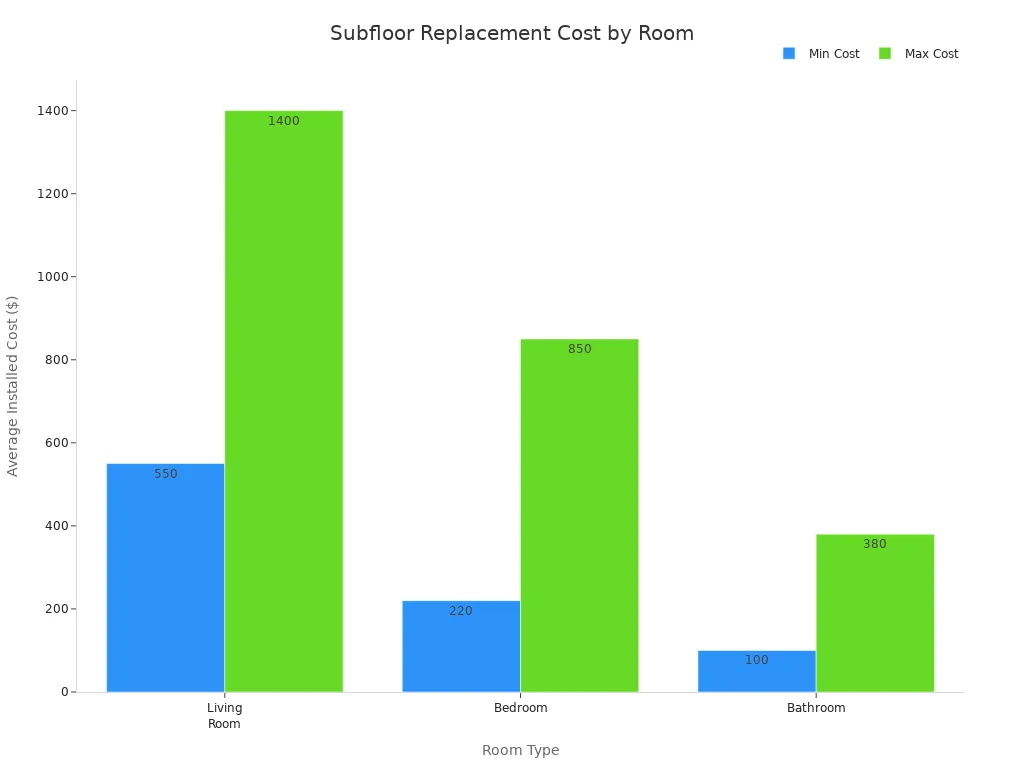
Take out all furniture before you start. If the room is big, you may need to stay somewhere else while the work is done. Make sure the subfloor is flat and dry before putting in new flooring.
Hallway
Hallways are narrow and can be hard for workers. The cost to replace subflooring in a hallway is $3 to $10 per square foot. Labor costs are higher because the space is tight. For a hallway about 230 square feet, the total cost can be $1,610 to $8,100. The price depends on how hard the job is.
Cost Aspect | Cost Range / Details |
|---|---|
Subfloor replacement cost | $3 to $10 per square foot (includes removal and disposal) |
Labor rates | $60 to $120 per hour; $0.60 to $4 per square foot depending on complexity and space |
Hallway flooring installation | $1,610 to $8,100 for ~230 sq. ft. |
Note: Narrow spaces make the job take longer. Workers need more time to finish in tight spots, so labor costs go up.
Laundry Room
Laundry rooms often get wet, so you need subfloor materials that resist water. The cost to replace subflooring in a laundry room is like the cost in a bathroom. It usually costs $500 to $1,000 for a space that is 50 to 100 square feet. If there is water damage or you need to move appliances, the price can be higher.
Basement/Other
Basements have special problems. Water and foundation issues can make subfloor replacement expensive. The cost to replace subflooring in a basement is $3,000 to $10,000. Fixing water damage alone can cost $1,200 to $5,000 for each room. If you need to fix the foundation, the price can go up to $20,000.
Issue Type | Impact on Subfloor Replacement Costs | Repair Methods / Notes |
|---|---|---|
Moisture Damage | $250 to $1,300 for removal, replacement, sealing, and mold remediation | Sealing costs $250-$700 to stop future damage. Mold cleanup may be needed. |
Foundation Problems | $4,500 to $20,000 for foundation repair | Repairs include mudjacking, underpinning, and joist reinforcement to fix sagging or uneven floors. |
Basement Subfloor Repairs | $1,000 to $8,000 due to concrete floors and complexity | This is more expensive because of water damage and cracks. It also needs concrete subfloor work. |
Water Damage Repair | $1,200 to $5,000 per room | This covers water removal, drying, and new flooring. |
If you need to remove mold or waterproof the basement, you will pay more. Adding drainage systems or fixing termite damage can also raise the total cost.
Cost Factors
Labor
Labor makes up a big part of the total cost to repair subfloor in any room. You will see labor rates from $30 to $50 per hour. These costs change based on where you live and how hard the job is. If your room has a complex layout or many corners, workers need more time. Urban areas often have higher labor costs because of union fees and local taxes. Simple jobs in rural areas may cost less, but you might have fewer skilled workers to choose from.
Materials
The type of materials you pick for subfloor replacement affects your total costs. Plywood is the most common choice. It costs between $2.75 and $6 per square foot installed. OSB is cheaper, at $3 to $4.40 per square foot, but it does not last as long if it gets wet. High-performance panels cost more but resist water better. Concrete is the most expensive and is best for basements or rooms with tile or stone.
Subfloor Material | Installed Cost per Sq.Ft. |
|---|---|
Plywood | $2.75 – $6 |
$3 – $4.40 | |
High-Performance | $3.50 – $10.50 |
Concrete | $4.25 – $12 |
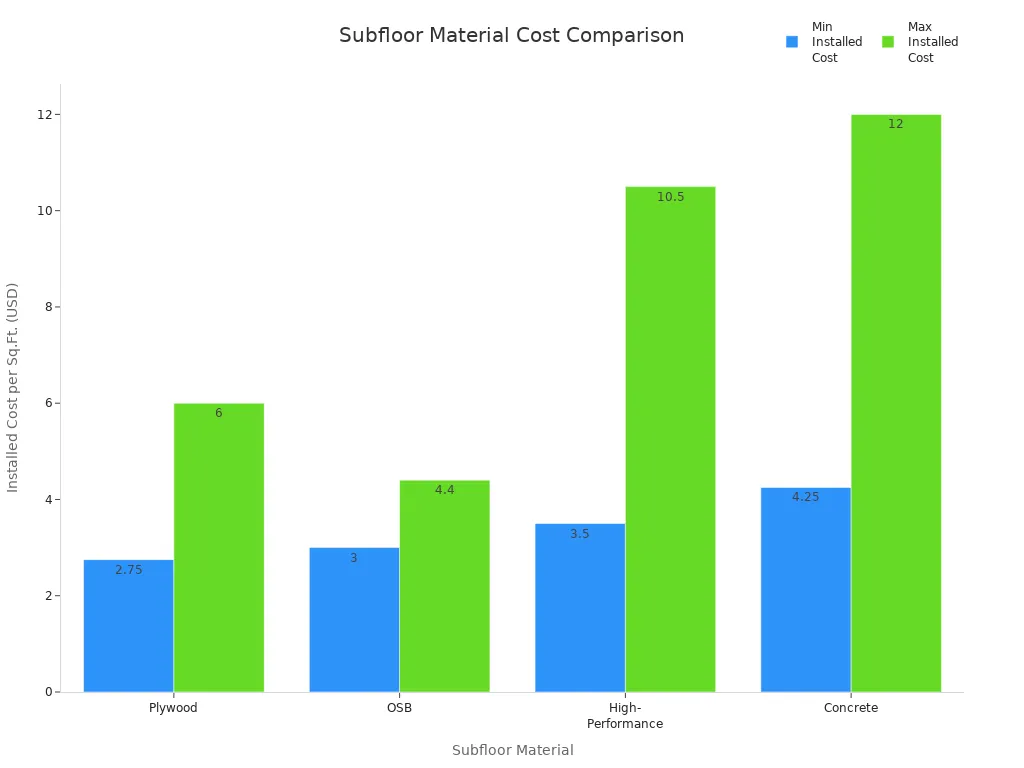
Room Size
Room size changes the average cost per square foot for subfloor replacement. Small repairs can cost $100 to $300. Full room replacement ranges from $500 to $1,200. Bigger rooms need more materials and labor, so costs go up.
Accessibility
You may pay more if workers need to move appliances or fixtures. Tight spaces, like hallways or laundry rooms, make the job harder. Crawlspaces or rooms with lots of plumbing also raise the cost.
Note: Moisture from plumbing or poor doors can cause more subfloor damage and increase costs.
Damage Extent
The amount of damage matters. Small surface problems cost less to fix. If you have water, termite, or foundation damage, costs can jump to thousands of dollars. Full subfloor replacement is much more expensive than patching a small area.
Region
Where you live affects costs. Cities have higher labor and material prices. Rural areas may have lower costs, but you might wait longer for skilled help. Local taxes and union fees also change the final price.
Example Breakdown
Sample Home
You might wonder how much it costs to replace the subfloor in a typical home. Let’s look at a sample home with several rooms. The table below shows a clear cost estimate for each room based on average sizes and recent data. These numbers help you plan your budget and avoid surprises.
Room | Typical Size (sq ft) | Average Cost Range (USD) |
|---|---|---|
Bedroom | 100 – 240 | $480 – $4,320 |
Bathroom | 40 – 50 | $240 – $960 |
Basement | 300 – 2,000 | $1,440 – $36,000 |
Kitchen | 64 – 200 | $360 – $3,600 |
Living/Family Room | 200 – 320 | $960 – $5,760 |
Laundry Room | 35 – 100 | $168 – $1,800 |
Entryway / Foyer | 36 – 120 | $180 – $2,160 |
Note: These numbers include labor and materials. You may pay extra for moving furniture, removing old flooring, or adding underlayment.
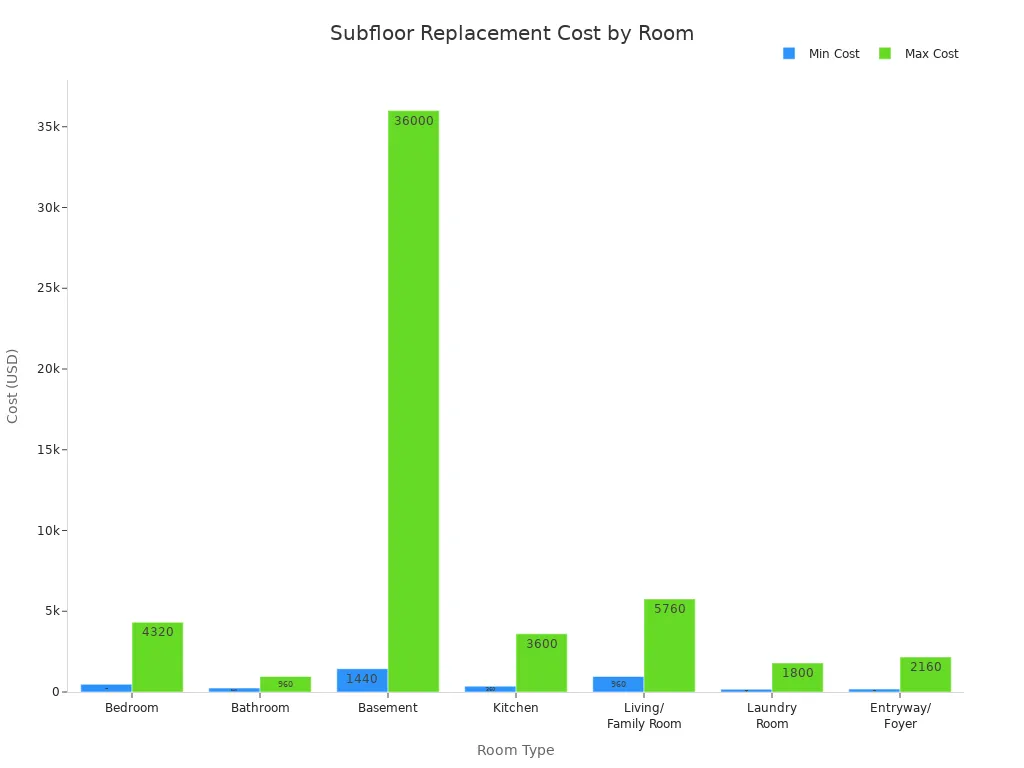
By Room
You can break down the estimate for each room by looking at the size and the work needed. For example, a 100-square-foot room might cost between $300 and $2,000. A larger 500-square-foot space could reach $10,000. The cost per square foot for subfloor replacement usually falls between $2.42 and $5.22. Labor for flooring installation adds $2.20 to $8.80 per square foot. Smaller rooms often have a higher per-square-foot estimate because setup and cleanup take more time.
Here are some cost estimate examples for different room sizes:
Room Size (sq.ft.) | Estimated Cost Range |
|---|---|
100 | $300 – $2,000 |
200 | $600 – $4,000 |
500 | $1,500 – $10,000 |
1,000 | $3,000 – $20,000 |
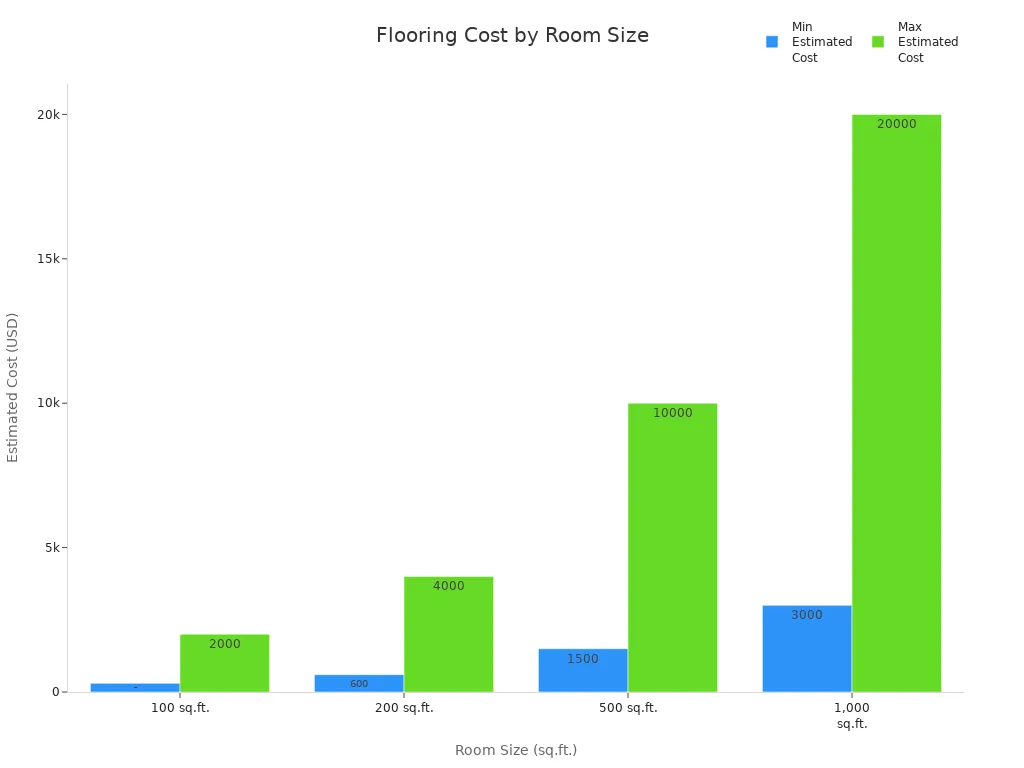
Tip: Always get a written estimate before you start. This helps you compare prices and choose the best option for your home.
Saving Tips
DIY vs. Pro
You can save money by replacing subflooring yourself, but you need to weigh the risks and benefits.
DIY projects cut out labor costs, which can be a big part of your budget.
You must buy or rent tools and materials, which adds to your expenses.
Mistakes can lead to costly repairs or damage to your new floor.
Professionals work faster and bring experience. They often include removal and disposal in their price.
Contractors may get materials at lower prices and offer warranties.
Tip: If you have little experience, hiring a pro may save you money in the long run.
Material Choices
Choosing the right material helps you control costs and improve durability.
Here is a quick comparison:
Subfloor Material | Cost Range (Per Sq. Ft.) | Key Features |
|---|---|---|
Plywood | $2.50 – $3.50 | Durable, best for dry areas |
OSB | $2.50 – $4.50 | Cheaper, swells with moisture |
Amdry | $3 – $10 | Moisture-resistant, insulated |
DRIcore | $2.50 – $9 | Moisture-proof, good for basements |
Barricade | $2 – $10 | Insulated, sound-dampening |
Warmboard | Around $7 | Supports radiant heating |
Concrete | Around $6 | Durable, moisture resistant |
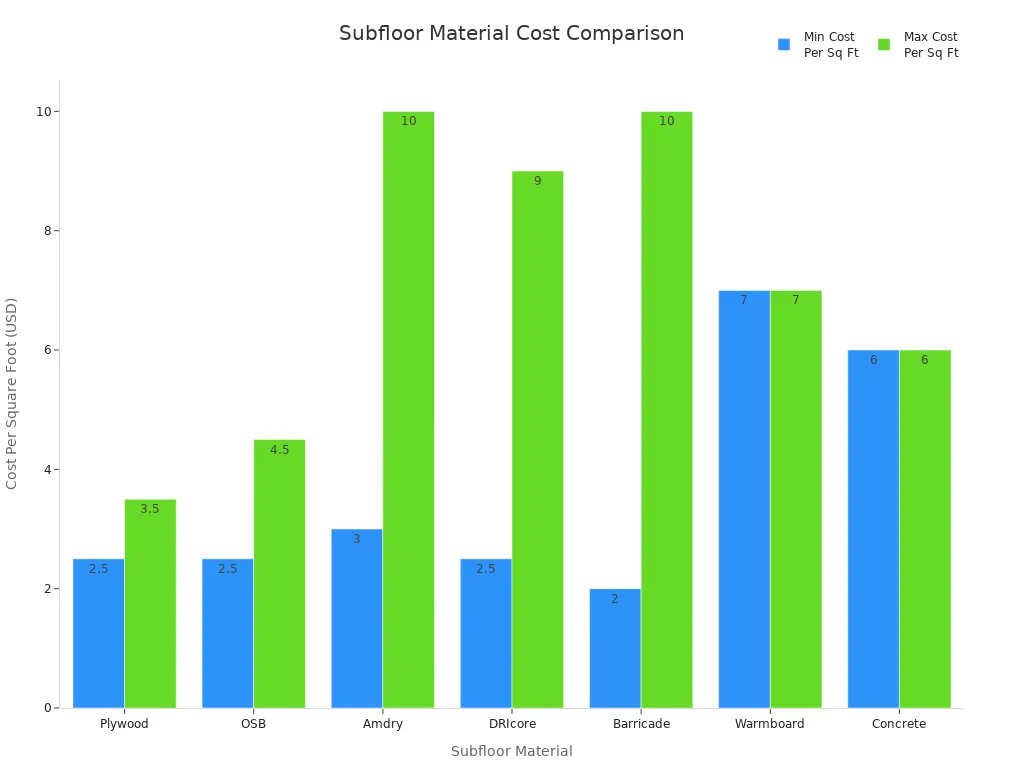
Bundling
You can save by bundling subfloor replacement in several rooms at once.
Contractors work more efficiently when they handle multiple rooms together.
You pay less for setup and labor than if you split the project.
Many contractors offer discounts for larger jobs.
Note: Ask for a bundled quote if you plan to update more than one room.
Timing
Start your project early and prepare well to avoid extra costs. Early inspection and good planning help you spot hidden problems before they get worse. If you delay, water damage or rot can increase your expenses. Careful timing and preparation keep your project on budget.
Prevention
You can avoid costly subfloor replacements by taking simple steps:
Remove wet rugs and furniture quickly.
Use fans and dehumidifiers to dry floors fast.
Clean up dirt and mud after spills or floods.
Check floors often for signs of damage.
Use moisture meters to make sure floors stay dry.
Regular care and quick repairs help your subfloor last longer and save you money.
You will see that the cost to replace subflooring changes a lot from room to room. The average cost for a bathroom is much lower than the average cost for a basement or living room. Costs depend on room size, materials, and labor. You should check the average costs for each space before you start. Always compare costs for materials and labor. Get quotes to see the true cost for your home. Plan your budget by looking at the average costs and possible extra costs. You can save on costs by choosing the right time and method.
FAQ
How do you know if your subfloor needs replacing?
You may notice squeaky floors, soft spots, or uneven surfaces. Water damage, mold, or a musty smell can also mean you need to replace your subfloor. Always check under the flooring if you see these signs.
Can you replace subflooring yourself?
You can replace subflooring if you have basic carpentry skills and the right tools. Removing old flooring and cutting new panels takes time and care. If you feel unsure, you should hire a professional for safety and quality.
How long does subfloor replacement take?
Most rooms take one to three days for subfloor replacement. The time depends on the room size and the amount of damage. Extra repairs or moving appliances can add more time to the project.
How can you estimate the cost before starting?
You can measure your room and check material prices. Use a subfloor repair calculator online to get a quick estimate. Always add extra for labor and unexpected repairs.
What is the best subfloor material for wet areas?
Plywood and high-performance panels work well in wet areas. These materials resist water and last longer. You should avoid OSB in bathrooms or laundry rooms because it swells when wet.
